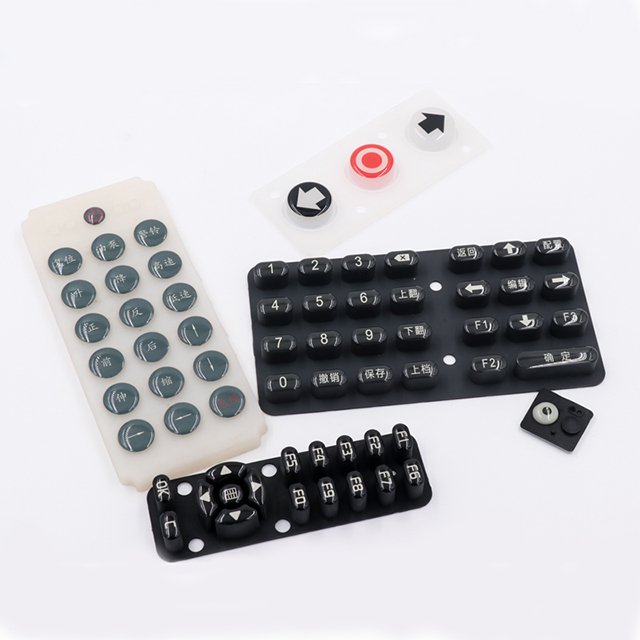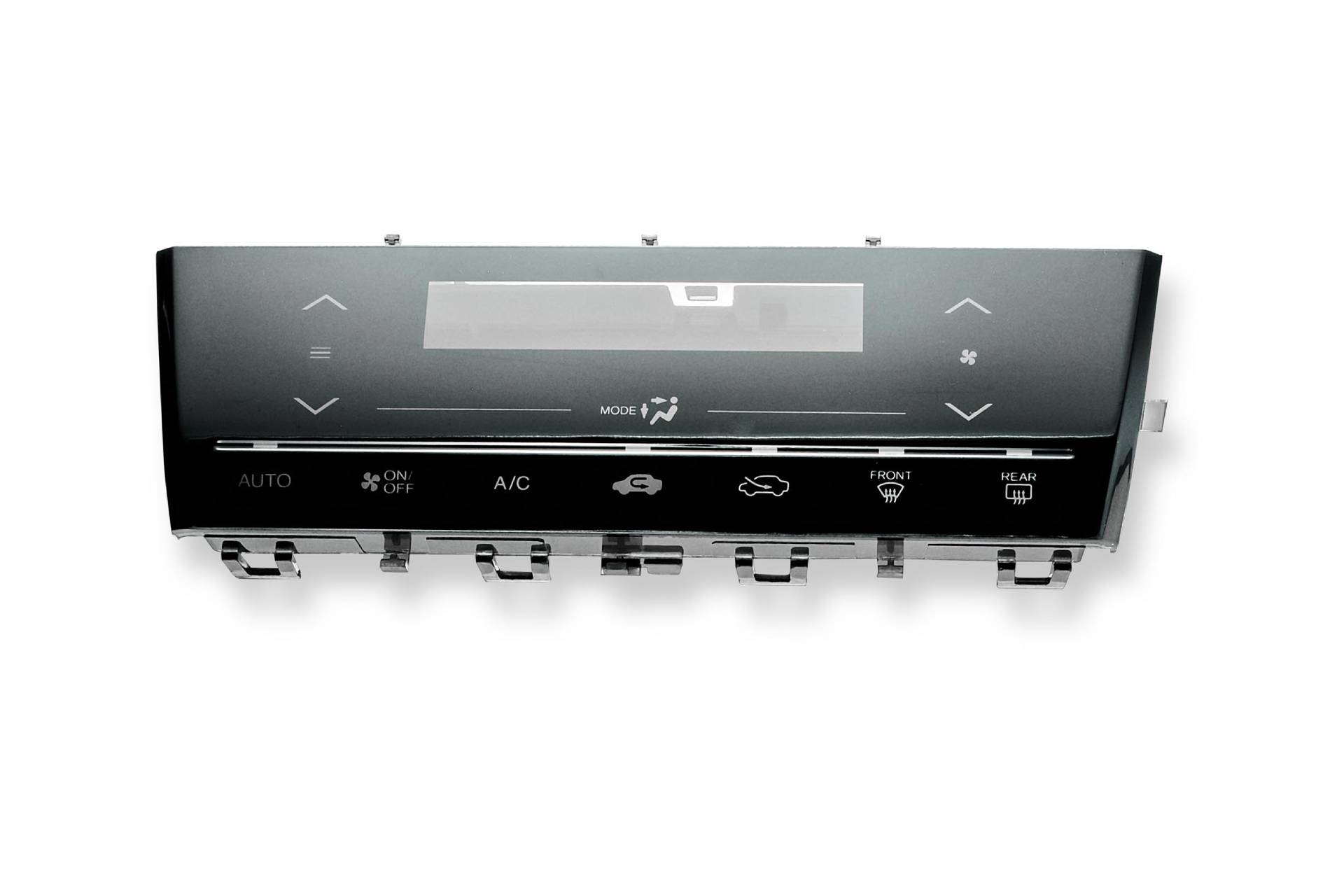A Comprehensive Guide to the Production and Handling of Rubber Keypads for Optimal Efficiency
The manufacturing and processing of rubber keypads play a necessary function in their performance and functionality. Product selection, layout accuracy, and advanced production methods substantially affect their toughness and performance. Comprehending these components is essential for developing high-quality items. As various developments emerge in this area, exploring their ramifications can expose brand-new criteria for capability and customer experience. What vital facets will form the future of rubber keypads?
Recognizing Rubber Keypads: Materials and Kinds
Rubber keypads are crucial components in countless devices, supplying a balance of durability and responsive feedback. These keypads are mainly made from silicone or synthetic rubber, products picked for their flexibility and strength. Silicone rubber, particularly, is preferred for its superb temperature level resistance and long life, making it suitable for different applications, from customer electronic devices to industrial equipment.
There are several kinds of rubber keypads, including dome button keypads, which use a dome-shaped device that provides tactile feedback when pushed. Additionally, there are likewise flat keypads, which feature a smooth surface area and are frequently utilized in remotes and clinical tools. The selection of product and kind influences the keypad's performance, feel, and general user experience. Comprehending these facets is essential for developers and suppliers intending to develop effective and reliable interfaces in their products.
The Manufacturing Process: From Style to Production
The production process of rubber keypads involves several vital stages, starting with layout and finishing with manufacturing. Originally, developers produce in-depth specs and models, ensuring the keypad satisfies useful and aesthetic demands. Computer-aided layout (CAD) software program is usually made use of to imagine the format and functions prior to proceeding.
When the layout is completed, material choice is necessary, with choices commonly including silicone or all-natural rubber. In the next phase, mold and mildews are produced based on the accepted designs, which will certainly form the keypads during manufacturing.
Complying with mold and mildew development, the manufacturing phase begins, where rubber is combined with ingredients to enhance performance. The mixture is after that put right into mold and mildews and subjected to warmth and pressure, permitting it to treat and solidify.
The ended up keypads go through top quality checks to confirm they meet well-known requirements, complied with by product packaging for circulation. This comprehensive process assurances peak efficiency in the final item.
Key Methods in Rubber Molding
In the domain of rubber keypads, numerous molding methods play an essential duty in identifying the top quality and performance of the last item. One prevalent method is compression molding, where raw rubber is positioned in a heated mold and mildew and stress is used, permitting efficient mass production and harmony. An additional substantial technique is shot molding, which involves injecting heated rubber right into a mold, using greater precision and complex shapes. Transfer molding, a hybrid of both methods, is likewise used, especially for complex styles, as it incorporates the benefits of both procedures. Furthermore, fluid silicone rubber (LSR) molding is obtaining grip because of its versatility and toughness, making it excellent for high-performance applications. Each strategy has special attributes, affecting elements such as cycle time, material waste, and manufacturing costs. Selecting the appropriate molding strategy is crucial for attaining peak efficiency in rubber keypads.
Surface Finishing and Texturing Options
Surface completing and texturing options play a necessary function in enhancing the tactile experience and visual appeal of rubber keypads. Producers utilize different methods to create distinct surface area attributes that affect individual communication and item layout. Typical completing approaches consist of matte, glossy, and satin finishes, each providing various aesthetic effects and grip levels. Texturing alternatives, such as increased patterns, grooves, or stippling, further boost capability by improving traction and lowering slippage during use.
Furthermore, specific textures can be tailored to meet ergonomic requirements, providing convenience during extended usage. The selection of surface coatings and textures can be influenced by the designated application of the keypad, whether it be for customer electronic devices, automotive controls, or industrial gadgets. Inevitably, careful factor to consider of these alternatives adds considerably to user fulfillment and general item efficiency, making them vital aspects in the style and manufacturing procedure of rubber keypads.
Quality Control Procedures in Rubber Keypad Production
Quality control procedures in rubber keypad manufacturing are critical for making certain item reliability and performance. These measures incorporate material selection standards, strenuous testing treatments, and rigid final examination criteria. With each other, they develop an extensive structure that assists producers promote high quality throughout the manufacturing process.

Product Option Requirements
Choosing the suitable materials for rubber keypads is essential, as it straight affects their resilience, individual, and capability experience. Secret requirements for material option consist of tensile toughness, resilience, and ecological resistance. The selection of rubber compound, such as silicone or polycarbonate elastomer (TPE), plays an important role in achieving desired responsive responses and durability. Furthermore, variables like chemical compatibility, temperature security, and UV resistance should be considered to ensure maximum performance in numerous applications. Producers need to additionally evaluate the simplicity of handling and cost-effectiveness of products, balancing top quality with budget plan restraints. Inevitably, the ideal product selection not only boosts the keypad's efficiency but additionally contributes to general item top quality and customer satisfaction.
Examining Treatments Executed
After figuring out the suitable materials for rubber keypads, strenuous screening treatments are executed to confirm that the end products satisfy sector standards and client assumptions. These procedures typically consist of mechanical testing, which examines the resilience and flexibility of the rubber under numerous conditions. In addition, ecological testing assesses the keypads' efficiency under temperature changes, moisture, and exposure to chemicals. Electric testing confirms the keypads function correctly with digital parts, validating responsiveness and conductivity. Tactile comments is examined to assure customer complete satisfaction. These extensive testing procedures are necessary in identifying any kind of disparities or flaws before mass production, ultimately boosting the dependability and performance of rubber keypads in their desired applications.

Final Examination Specifications
Complete final inspection requirements are crucial in rubber keypad production to guarantee that each unit meets the defined requirements for capability and look. This procedure generally includes visual assessments to determine any kind of surface issues, such as discoloration or blemishes. Additionally, responsive examinations ascertain that the keypads react accurately to touch, maintaining the needed level of sensitivity. Resilience tests may additionally be carried out, replicating extended use to validate the durability of the keypad under numerous conditions. Additionally, adherence to industry laws and client requirements is validated to maintain high quality assurance. By carrying out these rigorous evaluation procedures, makers can considerably decrease the risk of problems, ensuring that the last product is reliable and satisfies consumer expectations, inevitably boosting consumer satisfaction.
Advancements in Rubber Keypad Technology
As innovation remains to evolve, developments in rubber keypad modern technology are improving interface across various sectors. One significant advancement is the assimilation of capacitive touch sensing units within rubber keypads, allowing for an extra flexible and receptive individual experience. This innovation allows customers to interact with tools with touch, improving performance without giving up the responsive feedback that rubber keypads are recognized for.
In addition, enhancements in material solutions have brought about the development of even more resilient, weather-resistant rubber, making keypads ideal for commercial and outdoor usage. Improved printing strategies additionally permit wikipedia reference high-resolution graphics and backlighting options, increasing exposure and aesthetic appeal.

Furthermore, advancements in producing procedures, such as 3D printing, are enabling customized styles and quick prototyping, simplifying production timelines. These technologies collectively contribute to a lot more effective and easy to use rubber keypads, guaranteeing they fulfill the needs of modern applications while preserving their core benefits.
Ideal Practices for Style and Functionality
Designing effective rubber keypads needs careful evaluation of both aesthetics and performance. Rubber Keypads. A well-designed keypad should stabilize ergonomic principles with aesthetic attract improve individual experience. Secret aspects include size, shape, and spacing of switches, guaranteeing they are simple to press while stopping unexpected activation. Using contrasting shades and appearances can improve presence and tactile comments, helping individuals in distinguishing in between tricks
In addition, the choice of products plays a vital function; high-quality rubber substances can boost longevity and resistance to wear. It is likewise vital to take right into account the assimilation of features such as backlighting and customized graphics, which can improve use in numerous atmospheres.
Lastly, prototyping and user screening are invaluable in the design process, permitting modifications based on real-world feedback. By sticking to these ideal methods, manufacturers can develop rubber keypads that not only look attractive yet likewise fulfill the useful needs of users effectively.
Often Asked Questions
Exactly how Do I Pick the Right Rubber Material for My Keypad?
To select the right rubber product for a keypad, one need to think about variables such as longevity, ecological resistance, tactile responses, and compatibility with the intended application, making sure ideal efficiency and user satisfaction in different problems.
What Are the Environmental Impacts of Rubber Keypad Manufacturing?
Rubber keypad production can result in ecological impacts such as deforestation for all-natural rubber sources, contamination from chemical procedures, and waste generation. Lasting methods and products can alleviate click for source a few of these unfavorable impacts on environments.
Can Rubber Keypads Be Recycled or Reused?
Rubber keypads can be recycled, but the process relies on the specific materials used in their production. Reusing them in various applications is additionally feasible, adding to throw away reduction and promoting sustainability in making practices.
What Is the Typical Lifespan of a Rubber Keypad?
The ordinary lifespan of a rubber keypad generally varies from 5 to 10 years, depending upon usage, environmental elements, and upkeep. Regular treatment can expand its capability, while too much wear might reduce its longevity.
Exist Any Wellness Issues Associated With Rubber Keypad Materials?
There are prospective wellness problems associated to rubber keypad materials, including allergies to certain chemicals and toxic irritants used in production. Correct handling and understanding of material make-up can alleviate these risks for individuals.
There are numerous kinds of rubber keypads, consisting of dome switch keypads, which make use of a dome-shaped system that offers responsive comments when pressed. Selecting the ideal products for rubber keypads is vital, as it directly influences their performance, sturdiness, and customer experience - Rubber Keypads. After figuring out the suitable products for rubber keypads, strenuous testing treatments are implemented to verify that the last items satisfy sector standards and consumer expectations. Rubber keypad production can lead to ecological go to this web-site impacts such as deforestation for all-natural rubber resources, pollution from chemical processes, and waste generation. Rubber keypads can be reused, however the process depends on the specific materials made use of in their manufacturing